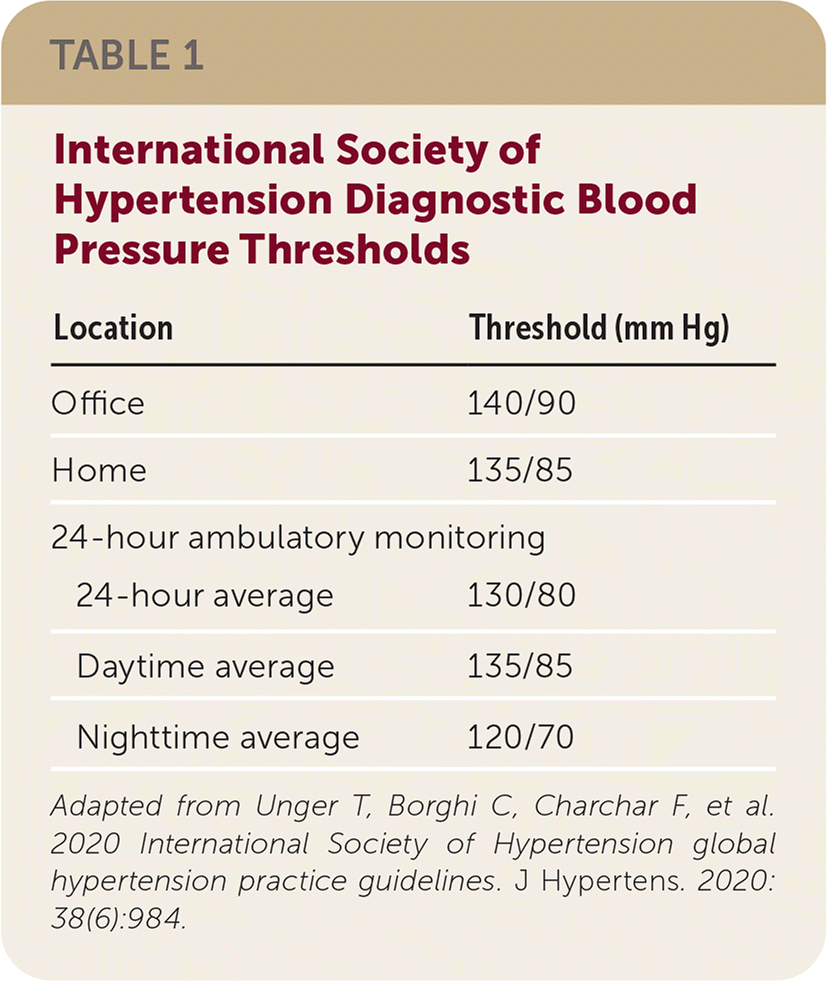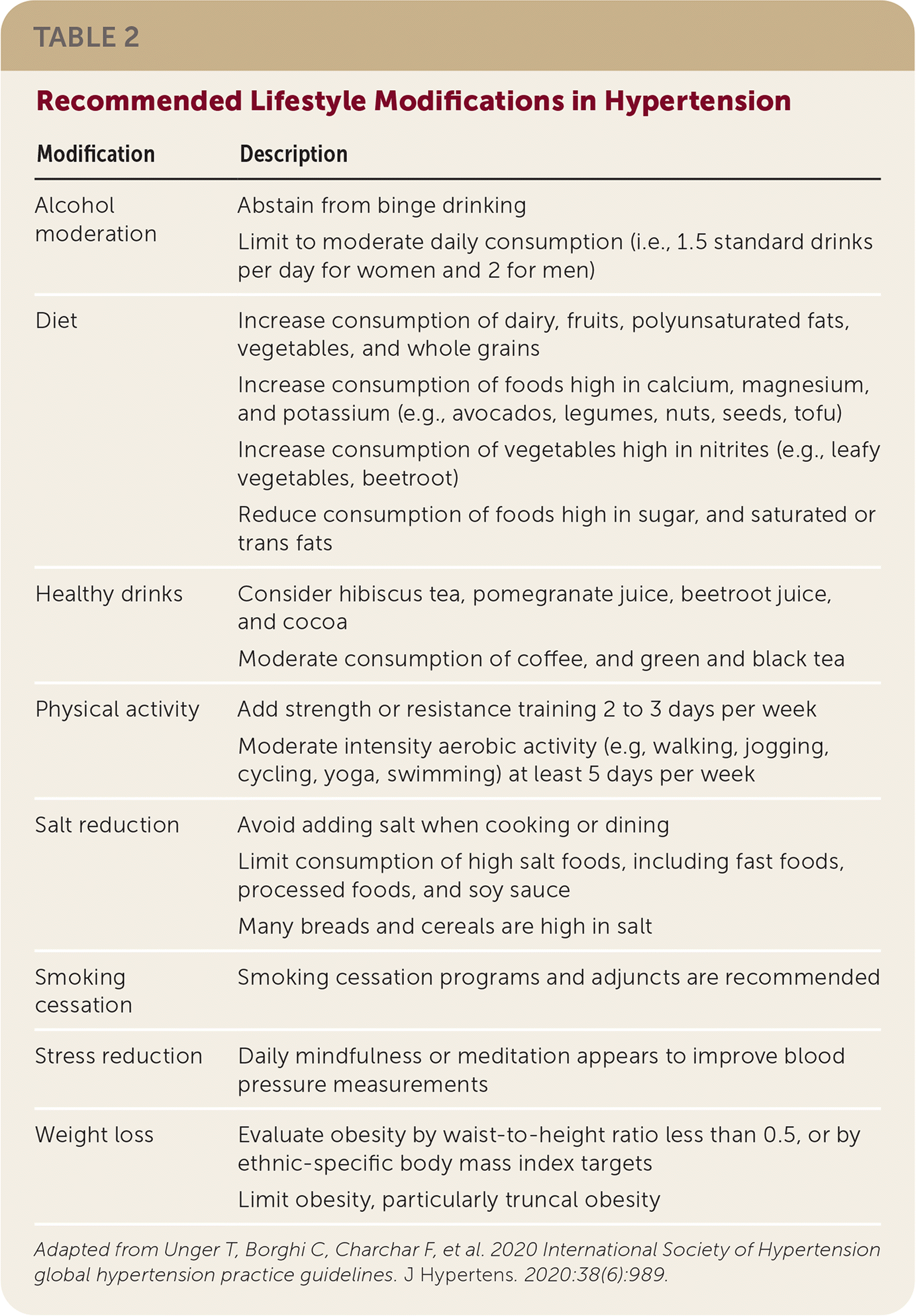
Am Fam Physician. 2021;103(12):763-765
Author disclosure: No relevant financial affiliations.
Key Points for Practice
• Use an average threshold of 140/90 mm Hg for office diagnosis of hypertension, but 135/85 mm Hg for home and 130/80 mm Hg for 24-hour ambulatory monitoring.
• Initial assessment in a patient who is hypertensive should evaluate for cardiovascular risk and any hypertension-mediated organ damage.
• Consider lifestyle interventions for three to six months before medication in patients with grade 1 hypertension and no comorbidities.
• After starting medication, target blood pressure is less than 140/90 mm Hg within three months, and after three months reduce target to less than 130/80 mm Hg in patients younger than 65 years.
From the AFP Editors
Hypertension is one of the leading causes of death globally each year, accounting for up to 30% of myocardial infarctions. Although the prevalence of hypertension is increasing, many patients are underdiagnosed and undertreated. The International Society of Hypertension (ISH) has published summary guidelines based on major international guidelines published between 2017 and 2020 on the control of hypertension. These summary guidelines include essential recommendations and suggestions for optimal care.
Diagnosis
Because blood pressure (BP) readings vary by measurement technique, diagnostic criteria are specific to the technique (Table 1). In health care settings that include the physician's office, hypertension is diagnosed when BP is 140/90 mm Hg or greater, ideally using an electronic device and following standard protocols for measurement, including repeat measurements.

| Location | Threshold (mm Hg) |
|---|---|
| Office | 140/90 |
| Home | 135/85 |
| 24-hour ambulatory monitoring | |
| 24-hour average | 130/80 |
| Daytime average | 135/85 |
| Nighttime average | 120/70 |
The ISH recommends categorizing grade 1 hypertension for BP levels less than 160/100 mm Hg and grade 2 hypertension for any higher BP levels. Hypertension should only be diagnosed from a single BP reading if the measurement is 180/110 mm Hg or higher with evidence of cardiovascular disease requiring immediate treatment. Otherwise, the patient should be reassessed every one to four weeks to confirm BP elevations.
Although outpatient office measurements continue to be the most common means of diagnosing hypertension, home and ambulatory readings are more consistent and better reflect hypertension-mediated organ damage risk. Out-of-office readings can differentiate white coat hypertension, with elevated office measurements, and masked hypertension, where measurements are lower in the office.
When BP is measured at home, hypertension is diagnosed if readings are consistently 135/85 mm Hg or greater. With 24-hour ambulatory monitoring, hypertension is diagnosed based on one of three criteria: 24-hour average BP of 130/80 mm Hg or greater, daytime average BP of 135/85 mm Hg or greater, or nighttime average BP of 120/70 mm Hg or greater.
Assessment
After diagnosing hypertension, further assessment is recommended to identify cardiovascular risk factors and signs of hypertension-mediated organ damage. The cardiovascular risk factors of diabetes mellitus, dyslipidemia, obesity, or nicotine use affect one-half of people with hypertension. In addition to history and physical examination, a cost-effective assessment includes serum chemistry levels, fasting glucose level, fasting lipid panel, urinalysis, and electrocardiography. Cardiovascular risk should be estimated using a calculator such as the Framingham Risk Score (https://www.mdcalc.com/framingham-risk-score-hard-coronary-heart-disease). Other studies, such as echocardiography, renal artery evaluation, or brain imaging, are not routinely recommended.
Treatment
Lifestyle modifications are essential for managing hypertension, and optimal treatment starts with diet and activity. Dietary changes include salt reduction, moderation of alcohol consumption, and a diet high in vegetables and fruit that is low in added sugars and saturated fats (e.g., DASH diet). Activity recommendations include aerobic and resistance exercises for at least 30 minutes or more at least five days per week. Other important modifications include smoking cessation and stress reduction (Table 2).

| Modification | Description |
|---|---|
| Alcohol moderation | Abstain from binge drinking |
| Limit to moderate daily consumption (i.e., 1.5 standard drinks per day for women and 2 for men) | |
| Diet | Increase consumption of dairy, fruits, polyunsaturated fats, vegetables, and whole grains |
| Increase consumption of foods high in calcium, magnesium, and potassium (e.g., avocados, legumes, nuts, seeds, tofu) | |
| Increase consumption of vegetables high in nitrites (e.g., leafy vegetables, beetroot) | |
| Reduce consumption of foods high in sugar, and saturated or trans fats | |
| Healthy drinks | Consider hibiscus tea, pomegranate juice, beetroot juice, and cocoa |
| Moderate consumption of coffee, and green and black tea | |
| Physical activity | Add strength or resistance training 2 to 3 days per week |
| Moderate intensity aerobic activity (e.g., walking, jogging, cycling, yoga, swimming) at least 5 days per week | |
| Salt reduction | Avoid adding salt when cooking or dining |
| Limit consumption of high salt foods, including fast foods, processed foods, and soy sauce | |
| Many breads and cereals are high in salt | |
| Smoking cessation | Smoking cessation programs and adjuncts are recommended |
| Stress reduction | Daily mindfulness or meditation appears to improve blood pressure measurements |
| Weight loss | Evaluate obesity by waist-to-height ratio less than 0.5, or by ethnic-specific body mass index targets |
| Limit obesity, particularly truncal obesity |
Because medications require long-term adherence, initiating medication can be delayed in many cases. When patients have grade 1 hypertension without cardiovascular disease, chronic kidney disease, diabetes, or signs of organ damage, lifestyle therapy for three to six months is recommended. Pharmacotherapy should be started if BP remains uncontrolled, especially in patients 50 years or older. Treatment should be initiated immediately in patients with comorbidities or grade 2 hypertension, if possible.
Within the first three months of starting pharmacotherapy, the BP target should be less than 140/90 mm Hg. Recommended long-term blood pressure targets are less than 130/80 mm Hg in patients younger than 65 years and less than 140/90 mm Hg in patients 65 years or older.
A single antihypertensive is recommended in low-risk grade 1 hypertension or in patients 80 years or older. Otherwise, low-dose combination therapy should be initiated, most often an angiotensin-converting enzyme inhibitor or angiotensin receptor blocker combined with a dihydropyridine calcium channel blocker. Increasing to full-dose treatment should be considered before adding a third anti-hypertensive, usually a thiazide-like diuretic if not already selected. Adding spironolactone is the next step, if full-dose treatment with three medications is ineffective. Beta blockers are not recommended unless indicated for other medical conditions.
Secondary hypertension affects up to 10% of people with hypertension. Secondary causes should be considered in patients 30 years or younger, especially without comorbidities, and any patient with resistant hypertension, sudden deterioration in control, severe BP elevations, or clinical signs of a cause for the secondary hypertension. Pseudo-secondary hypertension caused by nonadherence and drug-induced hypertension should be excluded before the evaluation. This evaluation should be guided by clinical presentation instead of a battery of tests.
Optimizing Adherence
Long-term adherence is challenging, and suboptimal management is commonly related to poor adherence. Adherence should be evaluated routinely, especially before escalating therapy. Adherence can be improved through strategies including combination pills, once-daily dosing, home BP monitoring, electronic reminders, and support from a multidisciplinary team. Pill counting, pharmacy record review, and witnessed intake of medications are objective ways to monitor adherence. Optimal interventions integrate counseling, self-monitoring, supervision, and reinforcement.
Editor's Note: The ISH guidelines are important because they successfully cut the Gordian knot of conflicting diagnosis thresholds and treatment targets in hypertension. They move us away from the 2017 American College of Cardiology/American Heart Association (ACC/AHA; https://www.aafp.org/afp/2018/0315/p413.html) guidelines, which recommended a diagnosis and treatment target of 130/80 mm Hg primarily based on a few large, well-controlled trials that are difficult to replicate in practice. As Dr. Michael LeFevre noted in an AFP editorial (https://www.aafp.org/afp/2018/0315/p372.html), “It is an overreach to take the results of existing trial data and label everyone who has a BP above 130/80 mm Hg as having uncontrolled hypertension, particularly when that label will be applied on the basis of the most recent routine office BP measurement.” Although the ACC/AHA guidelines recommend that everyone diagnosed with hypertension be verified with home or 24-hour ambulatory monitoring, this service is not uniformly available. Similarly, the ACC/AHA guidelines did not account for the increased harms of over-treatment in older adults. For these reasons, the American Academy of Family Physicians (AAFP) declined to endorse the ACC/AHA guidelines and continues to endorse the 2014 Evidence-Based Guideline for the Management of High Blood Pressure in Adults from the Eighth Joint National Committee (https://www.aafp.org/family-physician/patient-care/clinical-recommendations/all-clinical-recommendations/highbloodpressure.html).
The ISH guidelines, which were assembled using reviews of the ACC/AHA guidelines and six other international guidelines, overcome this conflict by providing separate diagnostic thresholds based on measurement techniques. Treatment targets are 140/90 mm Hg for the initial months of treatment and for older adults, reflecting concerns noted by the AAFP. The AAFP will not endorse the ISH guidelines because of their summary nature, but the ISH guidelines provide family physicians with a concise guide for treating hypertension that aligns well with our clinical practice.—Michael J. Arnold, MD, Contributing Editor
The views expressed in this article are those of the authors and do not necessarily reflect the official policy or position of the Department of the Navy, Uniformed Services University of the Health Sciences, Department of Defense, Department of Veterans Affairs, or the U.S. government.
Guideline source: International Society of Hypertension
Evidence rating system used? No
Systematic literature search described? No
Guideline developed by participants without relevant financial ties to industry? No
Recommendations based on patient-oriented outcomes? Yes
Published source: J Hypertens. June 2020;38(6):982–1004
